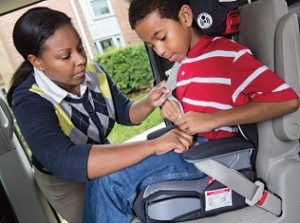
The new GMC system is simple: if it senses you've opened the rear door it will issue an alert when you leave the vehicle.
A Mississippi father is facing charges of second-degree murder after leaving his infant child in an overheated car where it succumbed to heatstroke. But the death of eight-month-old Shania Caradine was far from a rare occurrence. So far, at least 12 children have reportedly died from heatstroke after being left in hot cars by their caregivers – a 240% increase from this time a year ago.
While experts say some of those incidents may have been intentional, the vast majority are considered an accident, a parent or caregiver becoming distracted or breaking from their normal routine. The challenge is to come up with a way to ensure that they don’t leave children – or other valuables – behind when they leave a vehicle.
General Motors is offering a potential solution on its 2017 GMC Acadia SUV, a system it calls the Rear Seat Reminder. It’s designed to detect when a motorist puts something in the back seat and then issue an alert when they’re ready to exit the vehicle. Child safety experts are hailing the concept as a good first step – but they also lament the fact that several even more sophisticated systems promised over the years have failed to materialize.
“The problem is a serious one,” said Kate Carr, president and CEO of the advocacy group Safe Kids Worldwide. There have been 670 known “preventable deaths” of children locked inside overheated vehicles since 1998, a figure that has jumped as high as 49 in a single year.
(Infiniti may add autonomous tech to most all new models. Click Here for the story.) According to the group’s research, 54% of those fatalities occurred when a parent or caregiver forgot there was a child insider the vehicle, something Carr said is surprisingly common. It can occur when a sleep-deprived parent, not normally responsible for taking a child to daycare, falls back into the morning routine and simply drives to work.
Another 29% of the fatalities involved children who climbed into a vehicle on their own, perhaps to pretend they were driving. The remaining 17% of the fatalities occurred when children were intentionally left behind – whether by a caregiver running an errand or, in a few instances, with malice in mind.
Whatever the reason, children can succumb to heatstroke in a matter of minutes, and it can happen on a seemingly cool day. A dark vehicle parked out in the open can rapidly heat up inside. One death this year occurred when the outside temperature was just 52 degrees, Carr noted.
All told, experts believe several thousand children annually are left in hot cars, and while only a small fraction die, “then there are the serious injuries,” said Janette Fennell, founder and president of KidsandCars.org. “The kids survive, but there’s brain damage and other permanent problems.”
Both Carr and Fennell encourage parents to come up with ways to remind themselves that there’s a child in the car. One effective trick is to put a briefcase, lunch bag or even a cellphone in the backseat next to a child. But such tricks may not always work.

Joshua Lewis Blunt has been charged with second-degree murder for the death of his infant daughter Shania Caradine.
“New technology must be added as quickly as possible on vehicles to help prevent these needless deaths and injuries,” said Fennell.
(Hacked Mitsubishi Outlander raises new concerns about automotive cybersecurity. Click Here to learn why.)
Both she and Carr hail the new GMC Rear Seat Reminder system which, if it proves successful, could be rolled out on other General Motors vehicles, according to the maker. But child safety advocates also lament the fact that even more sophisticated technology has failed to materialize, despite years of promise and hope.
Way back in 2002, for example, former GM Vice Chairman Harry Pearce unveiled a system that, he said, could detect the heartbeat of a child left in a car and then measure the vehicle’s temperature. If it was becoming dangerously hot, it would chirp the horn to alert a parent or passersby.
While Pearce declared “We are committed to putting this technology into production,” during a New York Auto Show news conference, it never proved reliable enough. Nor have technologies previewed by Ford and other manufacturers.
Several aftermarket systems have been brought to market, including some that attach to a child safety seat, but reliability has been a concern, according to federal safety regulators.
Unless and until some new and even more effective technology can be brought to market, experts lament, still more children will die needlessly each year when they become trapped inside overheated vehicles.
(Toyota tells dealers to disclose when new vehicles will face future Takata airbag recalls. Click Here for the story.)


Since the front passenger seat has a weight sensing device to control the force of deployment of the air- bag. Why can’t they also employ a sensor in the rear seats to remind the driver there’s a passenger in the auto.?
I know another thing that could help,
COMMON SENSE!!
How about a heartbeat detector and that be turned on/off. People with children leave it on. When the vehicle is off and it detects a heartbeat inside the vehicle, the vehicle starts with the A/C on.
CHILDCHECKMATE.COM
There is a product on the market that parents can buy today that can prevent hot car death. http://www.carseatmonitor.com and http://www.driverslittlehelper.com. If parents would only use this smartphone car seat monitor App – accidents like this wouldn’t happen and innocent lives would not be lost. Responsible parents don’t think it could happen, but it can and does. On average over 37 children die every year from being left behind in a hot car.